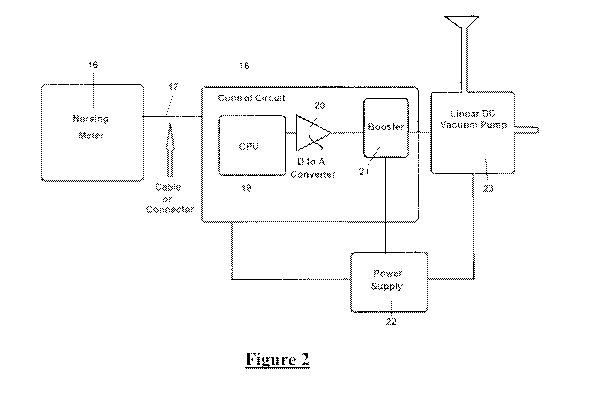Some of the information on this Web page has been provided by external sources. The Government of Canada is not responsible for the accuracy, reliability or currency of the information supplied by external sources. Users wishing to rely upon this information should consult directly with the source of the information. Content provided by external sources is not subject to official languages, privacy and accessibility requirements.
Any discrepancies in the text and image of the Claims and Abstract are due to differing posting times. Text of the Claims and Abstract are posted:
| (12) Patent Application: | (11) CA 2850021 |
|---|---|
| (54) English Title: | METHOD AND APPARATUS FOR CONTROLING FLOW RATES AND PATTERNS OF HUMAN MILK SECRETION BY A BREAST PUMP |
| (54) French Title: | PROCEDE ET APPAREIL DE REGULATION DES DEBITS ET DES MODELES DE SECRETION DE LAIT HUMAIN FAISANT APPEL A UNE POMPE TIRE-LAIT |
| Status: | Deemed Abandoned and Beyond the Period of Reinstatement - Pending Response to Notice of Disregarded Communication |
| (51) International Patent Classification (IPC): |
|
|---|---|
| (72) Inventors : |
|
| (73) Owners : |
|
| (71) Applicants : |
|
| (74) Agent: | BLAKE, CASSELS & GRAYDON LLP |
| (74) Associate agent: | |
| (45) Issued: | |
| (86) PCT Filing Date: | 2012-09-24 |
| (87) Open to Public Inspection: | 2013-04-04 |
| Examination requested: | 2017-09-15 |
| Availability of licence: | N/A |
| Dedicated to the Public: | N/A |
| (25) Language of filing: | English |
| Patent Cooperation Treaty (PCT): | Yes |
|---|---|
| (86) PCT Filing Number: | PCT/IL2012/050387 |
| (87) International Publication Number: | WO 2013046206 |
| (85) National Entry: | 2014-03-25 |
| (30) Application Priority Data: | ||||||
|---|---|---|---|---|---|---|
|
The invention relates to an apparatus and method to control the flow rates and pattern of human milk secretion while using a breast pump. The apparatus comprises a breast pump having a linear source of vacuum and a communication port for communicating with an external source of information on milk flow rates and patterns of a breastfeeding baby, through an external control circuit.
La présente invention concerne un appareil et un procédé qui permettent de réguler les débits et le modèle de sécrétion de lait humain lorsqu'on utilise une pompe tire-lait. L'appareil comprend une pompe tire-lait comportant une source linéaire de vide et un orifice de communication permettant de communiquer avec une source extérieure des informations relatives aux débits de lait et aux modèles de consommation d'un nourrisson alimenté au sein, au moyen d'un circuit de commande extérieur.
Note: Claims are shown in the official language in which they were submitted.
Note: Descriptions are shown in the official language in which they were submitted.

2024-08-01:As part of the Next Generation Patents (NGP) transition, the Canadian Patents Database (CPD) now contains a more detailed Event History, which replicates the Event Log of our new back-office solution.
Please note that "Inactive:" events refers to events no longer in use in our new back-office solution.
For a clearer understanding of the status of the application/patent presented on this page, the site Disclaimer , as well as the definitions for Patent , Event History , Maintenance Fee and Payment History should be consulted.
| Description | Date |
|---|---|
| Inactive: Dead - No reply to s.30(2) Rules requisition | 2019-09-09 |
| Application Not Reinstated by Deadline | 2019-09-09 |
| Deemed Abandoned - Failure to Respond to Maintenance Fee Notice | 2018-09-24 |
| Inactive: Abandoned - No reply to s.30(2) Rules requisition | 2018-09-07 |
| Inactive: S.30(2) Rules - Examiner requisition | 2018-03-07 |
| Inactive: Report - No QC | 2018-03-05 |
| Letter Sent | 2017-09-21 |
| All Requirements for Examination Determined Compliant | 2017-09-15 |
| Request for Examination Requirements Determined Compliant | 2017-09-15 |
| Request for Examination Received | 2017-09-15 |
| Inactive: Office letter | 2016-05-05 |
| Letter Sent | 2016-04-08 |
| Inactive: Notice - National entry - No RFE | 2014-06-06 |
| Inactive: Cover page published | 2014-05-15 |
| Correct Applicant Requirements Determined Compliant | 2014-05-08 |
| Inactive: Notice - National entry - No RFE | 2014-05-08 |
| Inactive: First IPC assigned | 2014-05-06 |
| Inactive: IPC assigned | 2014-05-06 |
| Application Received - PCT | 2014-05-06 |
| National Entry Requirements Determined Compliant | 2014-03-25 |
| Application Published (Open to Public Inspection) | 2013-04-04 |
| Abandonment Date | Reason | Reinstatement Date |
|---|---|---|
| 2018-09-24 |
The last payment was received on 2017-09-14
Note : If the full payment has not been received on or before the date indicated, a further fee may be required which may be one of the following
Please refer to the CIPO Patent Fees web page to see all current fee amounts.
| Fee Type | Anniversary Year | Due Date | Paid Date |
|---|---|---|---|
| MF (application, 2nd anniv.) - standard | 02 | 2014-09-24 | 2014-03-25 |
| Basic national fee - standard | 2014-03-25 | ||
| MF (application, 3rd anniv.) - standard | 03 | 2015-09-24 | 2015-09-10 |
| Registration of a document | 2016-03-29 | ||
| MF (application, 4th anniv.) - standard | 04 | 2016-09-26 | 2016-09-21 |
| MF (application, 5th anniv.) - standard | 05 | 2017-09-25 | 2017-09-14 |
| Request for examination - standard | 2017-09-15 |
Note: Records showing the ownership history in alphabetical order.
| Current Owners on Record |
|---|
| VASA APPLIED TECHNOLOGIES LTD |
| Past Owners on Record |
|---|
| YAAKOV POLGAR |
| YOAV SELLA |